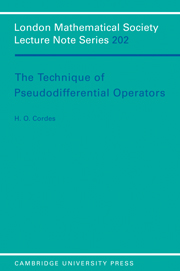Book contents
- Frontmatter
- Contents
- Preface
- Chapter 0 Introductory discussions
- Chapter 1 Calculus of pseudodifferential operators
- Chapter 2 Elliptic operators and parametrices in ℝn
- Chapter 3 L2-Sobolev theory and applications
- Chapter 4 Pseudodifferential operators on manifolds with conical ends
- Chapter 5 Elliptic and paraolic problems
- Chapter 6 Hyperbolic first order systems
- Chapter 7 Hyperbolic differential equations
- Chapter 8 Pseudodifferential operators as smooth operators of L(H)
- Chapter 9 Particle flow and invariant algebra of a semi-strictly hyperbolic system; coordinate invariance of Opψxm.
- Chapter 10 The invariant algebra of the Dirac equation
- References
- Index
Chapter 2 - Elliptic operators and parametrices in ℝn
Published online by Cambridge University Press: 09 February 2010
- Frontmatter
- Contents
- Preface
- Chapter 0 Introductory discussions
- Chapter 1 Calculus of pseudodifferential operators
- Chapter 2 Elliptic operators and parametrices in ℝn
- Chapter 3 L2-Sobolev theory and applications
- Chapter 4 Pseudodifferential operators on manifolds with conical ends
- Chapter 5 Elliptic and paraolic problems
- Chapter 6 Hyperbolic first order systems
- Chapter 7 Hyperbolic differential equations
- Chapter 8 Pseudodifferential operators as smooth operators of L(H)
- Chapter 9 Particle flow and invariant algebra of a semi-strictly hyperbolic system; coordinate invariance of Opψxm.
- Chapter 10 The invariant algebra of the Dirac equation
- References
- Index
Summary
Introduction.
In this chapter we focus at the main feature of our algebras Opψhρ,δ : They contain (generalized) inverses of some of their operators – called (md-)(hypo-)elliptic. For historical reason such an inverse is called parametrix or Green inverse. Speaking algebraically, we deal with inverses modulo some 2-sided ideal, either the class of integral operators with kernel in s(ℝ2n) (K-paramemetrix), or the operators of with finite rank (Green inverse).
Integral operators with kernel in s(ℝ2n) are compact operators of L2 (ℝn) as well as in every Sobolev space (cf.III,5). Thus a K-parametrix (Green inverse) of A will be an inverse mod K(H) (a Fredholm inverse) as well, under proper assumptions, giving normal solvability of the equation Au=f (cf. [C1], App.Al).
For Opψhm, ρ, δ ‘elliptic’ usually will be ‘md-elliptic’, amounting to ellipticity ‘at |ξ|=∞’ and ‘at |x|=∞’-i.e., “d-” and “m-” ellipticity. This is parallel to discussions in algebras of singular integral operators ([C1],[C2): For operators of order 0 ‘mdelliptic’ simply means that the symbol is ≠0 at |x| + |ξ|=∞.
An md-elliptic operator of order m will have a K-parametrix of order -m, and existence of a K-parametrix of order -m is in fact necessary and sufficient for md-ellipticity of A∈ Opψhm,ρ,δ. However, it is possible for a non-md-elliptic operator to have a K-parametrix of order >-m. One such class of operators – the formally md-hypo-elliptic operators – is studied in sec.2.
The ellipticity concept can be localized, in the x-variable as well as in the ξ-variable, and ‘local parametrices’ may be constructed under various assumptions.
- Type
- Chapter
- Information
- The Technique of Pseudodifferential Operators , pp. 81 - 98Publisher: Cambridge University PressPrint publication year: 1995



